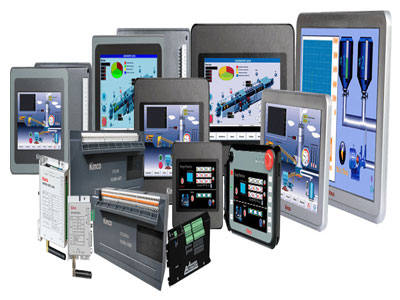How Does The HMI Work?
Key Takeaway
An HMI (Human-Machine Interface) works as a bridge between an operator and a machine, allowing real-time interaction and control. It replaces traditional switches and dials with a digital display where operators can input commands and receive feedback. The HMI communicates with devices like PLCs (Programmable Logic Controllers) or RTUs (Remote Terminal Units), gathering data and presenting it visually.
Operators can use the HMI to start or stop processes, adjust settings, and monitor the machine’s performance. The graphical interface simplifies complex operations, helping the operator to manage systems more effectively. The HMI also provides real-time alerts and notifications to help prevent machine malfunctions, improving safety and efficiency.
Data Input Mechanism in HMI
The data input mechanism in an HMI is the first step in how it operates. An operator interacts with the HMI through various input devices, such as a touchscreen, keyboard, mouse, or control panel. This input is typically in the form of commands that instruct the machine to perform certain tasks, adjust settings, or monitor specific parameters. In more advanced HMI systems, inputs can include voice commands or gesture recognition.
Once an input is received, the HMI communicates this information to the underlying control system, such as a PLC (Programmable Logic Controller) or a Distributed Control System (DCS). The ease of use in data input mechanisms makes HMI highly efficient, allowing operators to interact with complex systems without needing to manually adjust the machines themselves. Input mechanisms can be customized to suit specific applications, making them adaptable to various industrial environments.

Processing Information in HMI Systems
After receiving input, the HMI processes this information to ensure that the appropriate commands are executed by the machine or system. This stage involves the HMI interpreting the data and relaying it to the machine in real-time. In most cases, HMI systems are integrated with PLCs or other control units that handle the logic of the commands provided by the operator.
The HMI processes inputs by converting them into machine-readable instructions. This might include adjusting the temperature of a machine, starting or stopping a production line, or increasing the speed of a conveyor belt. The HMI also processes feedback from the machines, allowing it to display real-time updates on the interface, ensuring the operator has full visibility of the machine’s current status. The processing phase is critical in maintaining efficient machine operation, as any delay or error could lead to operational inefficiencies or downtime.
You May Like to Read
Data Output via Display and Feedback
Once the HMI processes the input, it generates output data, which is then displayed on the interface. This data output can come in the form of visual feedback, such as graphs, alarms, or system statuses. The HMI ensures that operators receive real-time feedback from machines, enabling them to monitor performance, detect issues, or adjust operations on the go.
For example, if a machine’s temperature exceeds safe operating levels, the HMI will alert the operator with an alarm or visual indicator on the display. This real-time feedback is crucial for minimizing downtime, as it allows operators to intervene before a minor issue becomes a major problem. HMIs also display detailed performance data, including production rates, energy usage, or material levels, allowing operators to optimize machine performance for maximum efficiency. The display is often customizable, allowing operators to configure what information is presented and how it is visualized.
Communication Between HMI and Machines
Effective communication between the HMI and machines is the backbone of how the system functions. The HMI uses communication protocols, such as Modbus, Ethernet/IP, or OPC UA, to transfer data between itself and machines or control systems like PLCs. These communication protocols ensure that data is sent and received accurately, facilitating real-time operations.
The communication between the HMI and machines is bidirectional, meaning that while operators input commands into the HMI, the machine also sends feedback data back to the HMI. This constant flow of information allows for quick adjustments and precise control. For instance, in a factory setting, an HMI can communicate with multiple machines simultaneously, centralizing control for the operator. This communication capability makes HMI systems indispensable in large-scale industrial operations where multiple machines and processes are integrated.
User Interaction with HMI Interfaces
User interaction is a critical part of how HMI systems work. The interface is designed to be intuitive, often featuring graphical elements such as buttons, sliders, and icons that allow operators to control machines easily. Touchscreen interfaces are common in modern HMI systems, making interaction more direct and reducing the complexity of machine control.
Operators can navigate through different screens, adjust machine settings, view real-time data, or respond to alarms—all through a user-friendly interface. The ability to customize the interface according to specific operational needs further enhances user interaction. For example, in a manufacturing plant, the HMI interface might be tailored to display critical information like production rates or machine health, making it easier for operators to make quick decisions. Ultimately, the user-friendly design of HMI systems minimizes human error and enhances overall productivity in industrial environments.
Conclusion
HMI systems are essential in industrial operations, serving as the critical link between human operators and machines. By allowing for seamless data input, real-time processing, and output through intuitive interfaces, HMIs ensure efficient control and monitoring of machines. These systems use robust communication protocols to ensure smooth interactions between machines and operators. From real-time feedback to user interaction, every element of HMI is designed to optimize machine performance, reduce downtime, and improve safety in industrial environments. Understanding how these systems work is crucial for anyone involved in modern manufacturing and automation.
